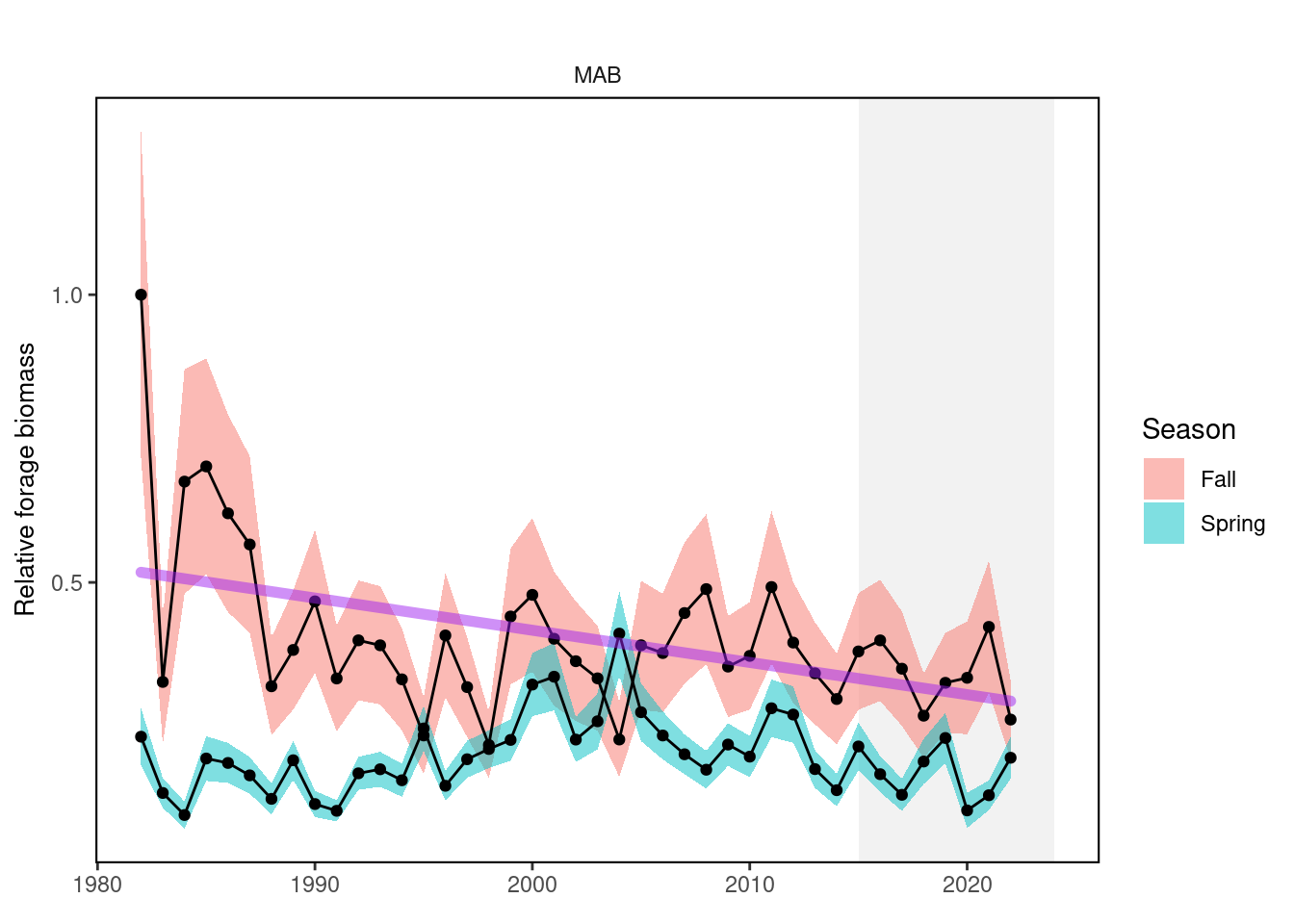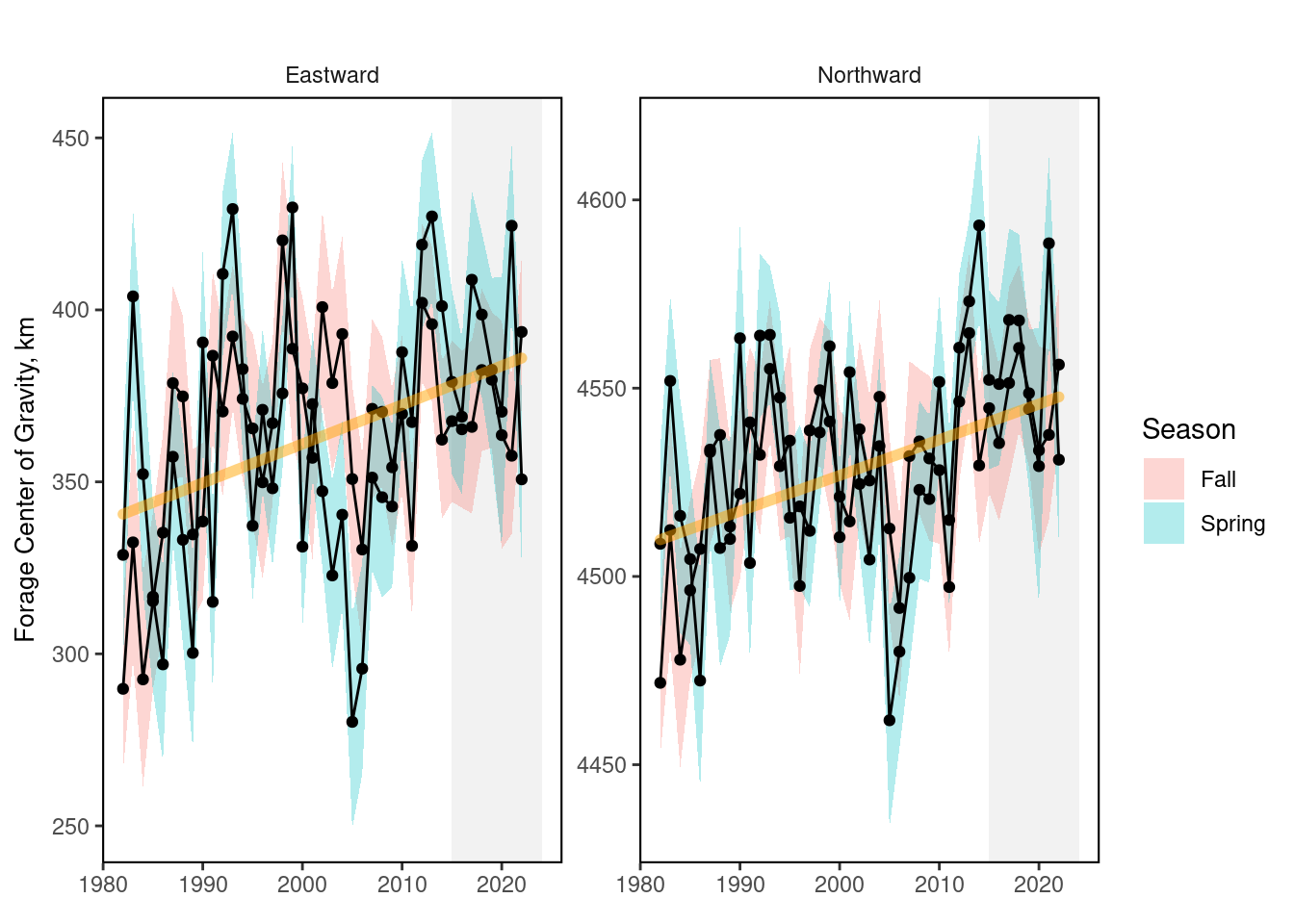23 Forage Fish Index
Description: Aggregate forage fish biomass index from fish stomach contents
Indicator family:
Contributor(s): Sarah Gaichas, James Gartland, Brian Smith, Anthony Wood, Elizabeth Ng, Michael Celestino, Katie Drew, Abigail Tyrell, and James Thorson
Affiliations: NEFSC
23.1 Introduction to Indicator
The amount of forage fish available in the ecosystem combined with the energy content of the forage species determines the amount of energy potentially available to predators in the ecosystem. Changes in the forage base could pose a risk to managed and protected species production. Spatially explicit indices of abundance for several forage species were estimated using spatio-temporal modeling (VAST, [6]; [7]). This spatially-explicit forage index estimated the combined biomass of 21 forage species using stomach contents information from 22 predatory fish species collected on bottom trawl surveys.
In addition to an index of forage abundance in each EPU, the coastwide center of gravity for the combined forage biomass was estimated. Consistent movement of the center of gravity towards the north or east indicates a distribution shift for combined forage fish.
23.2 Key Results and Visualizations
Variables plotted are Fall Forage Fish Biomass Estimate and Spring Forage Fish Biomass Estimate with error bands from Fall Forage Fish Biomass Estimate SE and Spring Forage Fish Biomass Estimate SE, respectively. Time series were extended back to 1982 and forward to 2023 in this update, but this did not change the trends reported previously for 1982-2022.
23.3 Indicator statistics
Spatial scale: by EPU and full shelf
Temporal scale: Spring (January-June), Fall (July-December)
Synthesis Theme:
23.4 Implications
The resulting indices for the Mid-Atlantic show a long term decrease in fall and overall higher forage fish in fall relative to spring, with highest forage biomass during fall in the early-1980s.
In New England, the forage index shows an overall higher forage fish biomass in fall relative to spring. There is a long-term increasing trend in the spring in GOM.
Changes in the distribution of forage biomass also affects predator distribution. Since 1982, the fall center of gravity of forage fish has moved to the north and east. The spring forage center of gravity shows higher variability than fall, and a significant trend to the north.
23.5 Get the data
Point of contact: Sarah Gaichas (Sarah.Gaichas@noaa.gov)
ecodata name: ecodata::forage_index
Variable definitions
Spring Forage Fish Biomass Estimate = aggregate forage fish biomass months 1-6, units relative grams per stomach
Spring Forage Fish Biomass Estimate SE = standard error of aggregate forage fish biomass months 1-6, units relative grams per stomach
Fall Forage Fish Biomass Estimate = aggregate forage fish biomass months 7-12, units relative grams per stomach
Fall Forage Fish Biomass Estimate SE = standard error of aggregate forage fish biomass months 7-12, units relative grams per stomach
Fall Eastward Forage Fish Center of Gravity = average eastward location of forage fish biomass months 7-12, units kilometers
Fall Eastward Forage Fish Center of Gravity SE = standard error of average eastward location of forage fish biomass months 7-12, units kilometers
Fall Northward Forage Fish Center of Gravity = average northward location of forage fish biomass months 7-12, units kilometers
Fall Northward Forage Fish Center of Gravity SE = standard error of average northward location of forage fish biomass months 7-12, units kilometers
Spring Eastward Forage Fish Center of Gravity = average eastward location of forage fish biomass months 1-6, units kilometers
Spring Eastward Forage Fish Center of Gravity SE = standard error of average eastward location of forage fish biomass months 1-6, units kilometers
Spring Northward Forage Fish Center of Gravity = average northward location of forage fish biomass months 1-6, units kilometers
Spring Northward Forage Fish Center of Gravity SE = standard error of average northward location of forage fish biomass months 1-6, units kilometers
Indicator Category:
23.6 Public Availability
Source data are publicly available. All data and code are available at https://github.com/NOAA-EDAB/forageindex
23.7 Accessibility and Constraints
No response
tech-doc link https://noaa-edab.github.io/tech-doc/forage_index.html



